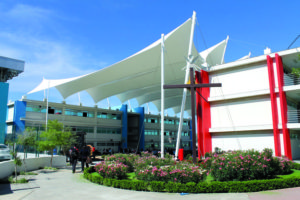 Fabric structures are a superior choice in many types of applications.
Fabric structures are a superior choice in many types of applications.
By Samuel J. Armijos, AIA, President, Fabric Architect LLC
Fabric structures have played and continue to play a huge role in architecture. Thirty years ago, the Haj Terminal in Saudi Arabia was on the cover of design and construction magazines all over the world. And the idea of creating modern tents for the modern nomad was the future. Sport stadiums were being enclosed with air structure roofs, and even traditional camping and party tents were getting a makeover.
New, pliable materials were being introduced for covering retail malls, Olympic venues and World Fair pavilions. These unique structures were built in Asia, Europe, Australia and the United States, and there was no limit for the use of the new materials.
Construction was booming worldwide—but it couldn’t last forever. And it didn’t. Money got tight and sustainability became a key word in the building industry. Buildings and materials needed to be environmentally friendly and their cost would be judged by their ability to provide physical, social and environmental benefits to the owner and its users.
Today, there are so many materials for designers to choose from. Why fabric? Which fabric? How do I get started? What’s the process?
Why fabric?
Places like schoolyards, sport fields and parking lots are areas that can get too hot for anyone. Trees can be added, sunblock can be used, but playground equipment gets hot, metal bleachers cause burns, and car interiors are unsafe after long hours of exposure to the sun.
What fabric structures solve for designers is a unique form of shelter that can be easily incorporated into space. Most importantly, these structures protect people from harmful UV rays, wind and rain. A shade structure over a playground shades children, their parents and pets. Covered bleachers at a sport stadium provide comfort to spectators and athletes. Fabric-covered-parking and equipment structures are ideal for keeping cars and mechanical systems cool and protect them from the elements.
Many sports are played indoors in pre-engineered buildings that require artificial lighting because the roof is made of a material that does not allow in natural daylight. However, playing in a fabric structure with a roof made of a translucent membrane that lets in natural daylight and reduces utility bills makes a lot of sense to building owners.
Fabric structures are used to transform an existing or a new building face. A blank wall, a south-facing curtain wall, or a dated parking garage all offer potential beyond their surfaces. An old parking garage face can be transformed with a new aesthetically pleasing textile façade, which then can change the look of a downtown. The idea of branding or advertising on a building has become common, and fabric is the primary building material of choice. For smart buildings and active building enclosures, a vertical membrane designed as an exterior shading device or a climate-controlling skin can improve energy performance.
Fabric structures continue to play a role in special events, whether it’s the Super Bowl, tennis tournaments or rock concerts. Retractable roof structures big enough to cover performers and the audience keep the show going. Rainouts are no longer an option, and rescheduling can affect millions. Fabric structures to the rescue.
The need to be green
A green trend is now a requirement. To be sustainable, recyclable materials, designed to reduce the carbon footprint and reduce the amount of energy required to have human comfort, must be considered. Fabric structures use materials that are recyclable or have little impact on landfills. Fabric structures do not use much energy to manufacture or install. Designed properly, these structures not only provide shade, but collect water, solar energy and make a huge impact to the bottom line.
Samuel J. Armijos, AIA, is an architect and the author of “Fabric Architecture: A Visual Resource for Shade, Signage and Shelter.” He is director of the consulting firm FabricArchitect.com.
Part 2 of the article will appear next month and will focus on fabric options, and the design-build process.
 TEXTILES.ORG
TEXTILES.ORG


